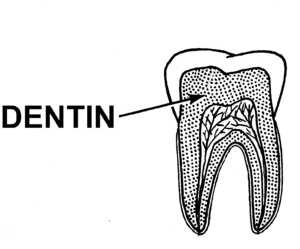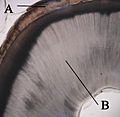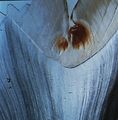Dentin facts for kids
Dentin is a strong, calcified tissue that forms the main part of your teeth. It's the second layer, found right under the hard outer layer called enamel in the top part of your tooth (the crown). In the root of your tooth, dentin is found under the cementum. Dentin makes up most of your tooth's structure and protects the soft inner part, the pulp, which contains nerves and blood vessels. Dentin is naturally yellowish, and because enamel is slightly see-through, the color of the dentin often shows through, giving your teeth their shade.
Contents
What is Dentin Made Of?
Dentin is a strong material, but it's not as hard as enamel. It's made up of different things:
- About 70% is a mineral called hydroxylapatite. This is the same mineral found in your bones.
- Around 20% is organic matter, which means it comes from living things. This includes proteins that give dentin some flexibility.
- The remaining 10% is water.
How Dentin Grows
The process of making dentin is called dentinogenesis. Special cells called odontoblasts are responsible for creating dentin. These cells start working when your teeth are forming. One cool thing about dentin is that, unlike enamel, your teeth can keep making more dentin throughout your life. This helps your teeth stay strong and healthy.
Types of Dentin
Dentin is made at different times and for different reasons. Scientists divide it into a few types:
Primary Dentin: The Main Part
Primary dentin is the type of dentin your tooth starts with. It forms the thickest part of your tooth, located between the enamel and the pulp. It's often called circumpulpal dentin because it surrounds the pulp. There's also a very thin, harder layer called mantle dentin, which is the first dentin formed near the tooth's crown.
Secondary Dentin: Lifelong Growth
Secondary dentin starts forming after your tooth has fully appeared in your mouth. This type of dentin is made slowly and continuously throughout your life. It forms closer to the pulp, adding extra protection as you get older.
Tertiary Dentin: Repairing Damage
Tertiary dentin is different because it's not made all the time. It only forms when your tooth gets damaged, for example, from a deep cavity or an injury. This special dentin acts like a natural patch, helping to protect the pulp from harm.
Images for kids
See also
 In Spanish: Dentina para niños
In Spanish: Dentina para niños





